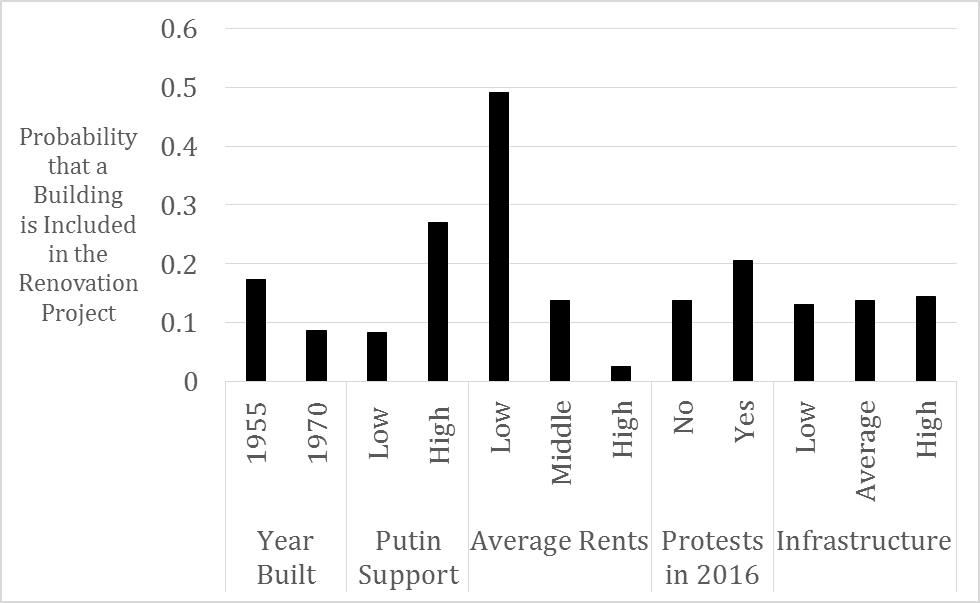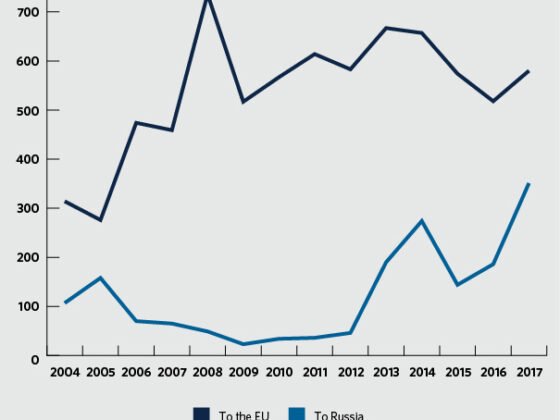(PONARS Policy Memo) In February 2017, Moscow Mayor Sergei Sobyanin and President Vladimir Putin introduced a far-reaching plan to demolish ten percent of Moscow’s housing stock, relocate residents, and ultimately provide them new housing. During their discussion, the mayor told Putin, “…we have mass appeals [for demolition from] the residents, municipal deputies, associations of deputies, and the Public Chamber of Moscow. We have reason to say that this is a people’s project.” Putin responded, “Let’s do it.” Despite this enthusiasm, the political risks of the monumental program were immediately evident in opposition framing. Politicians referred to it as the Moscow Renovation Project while Muscovites referred to it as a demolition program (“snos” in Russian). The policy sparked significant popular protest in a period of growing social unrest.
Announcing the extensive plans in a presidential and mayoral election year suggests that the Kremlin acted to shore up its far-reaching system of electoral influence that includes workplace mobilization, institutional changes, repression, and engineered ballots. While these tactics delivered strong victories in regional and State Duma elections over the past six years, they are less suited to the presidential race. While the winner of the March 2018 election is not in doubt, the message sent by the referendum on Putin’s regime is uncertain. The argument here is that the reconstruction policy is best understood as a new tool of electoral management by using targeted social spending as a carrot and stick mechanism to win voter support. As University of Manchester Lecturer Denis Volkov has noted, in the previous election cycle, increased social spending proposed in the so-called May Decrees failed to win over voters. The housing program was distinct in that it rested on a broadly publicized policy process of policy formation and implementation that projected regime responsiveness to the demands of the electorate. The patterns of houses included in the program also sent a signal that access to state benefits would be contingent on district-level election support for regime candidates.
Explaining the Policy: Social Welfare, Corruption, and Electoral Effects
The housing component of urban revitalization extends the policy of previous Moscow Mayor Yury Luzhkov that replaced 1,722 apartment buildings between 1999 and 2018. It also extends Sobyanin’s 2015 “My Street” project that aims for urban renewal and improvement prior to this year’s World Cup football competition. Like Luzhkov’s project, the recent renovation program targets five- and nine-story apartment buildings (“khrushchevki”), which were designed to meet the urgent housing needs of Soviet workers. Engineers designed these prefab buildings to last twenty-five years. Sixty years later, they constitute ten percent of Moscow’s housing stock.
Sobyanin’s proposal identified 8,000 buildings eligible for demolition based on poor condition, residents’ petitions, and input from local representatives. After an initial assessment based on informal polls and engineering surveys, the mayor’s office released a list of buildings to be included in the first stage: 4,566 buildings in 85 Moscow districts (includes six districts that were annexed by the metropolis in 2012). In subsequent rounds, any building in the renovation zone could opt in if two-thirds of the residents supported inclusion. By the end of that process, the list of buildings included in the first stage grew to 5,175 structures that house approximately one million Muscovites.
While the regime argued that the program addresses citizens’ needs, the announcement immediately provoked speculation about its true goals. Many observers argued that the mayor and his administration will use the program to generate elite support through the distribution of rent streams. Moscow construction is notoriously corrupt, creating revenue through preferential contracting, kickbacks, and bribes at all stages. An April 2017 VTsIOM poll demonstrated that many Muscovites believed that corruption is a plausible motivation for the project. A more nuanced version of this argument stresses the effects of economic crisis—falling prices and low demand—suggesting that the program constitutes an industry bailout. If the goal is to maximize rents, one would expect renovation to be concentrated in good neighborhoods where apartments command higher sale prices.
A second set of explanations focused on electoral incentives. A Meduza article argued that Sobyanin’s administration developed the program in early 2014 and revived it in 2016 to reward regime loyalists and win the hearts and minds of Muscovites. Opposition supporters countered that Sobyanin devised the program in retaliation against residents who voted for Alexei Navalny in the 2013 mayoral election.
Writing about pre-1996 Mexico, Stanford University Professor Beatriz Magaloni (2007) argues that threats of retribution and reward combine to form a punishment regime in which voters support regime candidates in order to maintain access to state resources. Since the regime cannot know individuals’ choices, the punishment is administered at the district level and fueled by rumor and innuendo. Assessing these arguments requires a judgement about the policy and electoral preferences of different groups of Muscovites. For the poor, newcomers, and those with limited infrastructure, the policy may appear as a windfall or an escape from intolerable housing. Yet, the program is vague on property rights protections, the exact nature of relocation processes, and the calculation of apartment values. Middle-class Muscovites who own renovated homes or live in nice neighborhoods are unlikely to trust the future promises. Past elections suggest that these groups are likely to have very different voting patterns.
To evaluate competing explanations, I worked with a team of researchers to collect building-level data on the year of construction, the size and value of individual apartments, demographics (number of children and number of pensioners), and the presence of house-level self-governance organizations, as well as aggregate data on the quality of neighborhood infrastructure and district voting patterns. Figure 1 reports the effect of these factors on the probability of housing being included in the project prior to resident voting.[1]
Figure 1. Explaining the Probability of a Building Being Selected for Inclusion in the Renovation Project

Interpreting these findings underscores the need to address nuances. Consistent with state claims, older apartments were more likely to be included in the program, but a significant number of newer buildings were included too. Evaluating economic motivations is also complex. High quality neighborhood infrastructure had a marginal effect on inclusion, while small apartment size and low property value profoundly increased the likelihood of inclusion. This finding highlights a secondary economic effect: relocation and buyout costs for these residents will be minimal compared with residents of more spacious units, thus increasing net profits. It also supports the argument that political support is increasingly tied to the distribution of public goods. Houses in regions with strong vote support for Putin were more likely to be included. While we do not show it in this figure, a high vote for Navalny in the 2013 mayoral elections slightly decreased the probability of apartments being included in the program. This suggests that the program was aimed at shoring up core vote support for Putin and Sobyanin, while creating the perception of punishment for Navalny voters. Despite the fact that some Navalny supporters living in excluded buildings may not feel punished at all, undoubtedly there are Putin voters in those districts who resent the actions of their neighbors and understand the need to remain loyal to receive benefits.
Conclusion
This preliminary analysis demonstrates that the policy fulfills more than one function: it rewards core voters, punishes districts that voted for Navalny, focuses on profitable targets of opportunity, divides social groups, and addresses some of the real problems in the housing stock. The Moscow housing renovation project provides the first empirical evidence of a punishment regime in Russia designed to win electoral support for the regime despite voters’ sincere preferences over candidates. In a system where experimentation with mechanisms to solve governance problems is a common practice, this effort may indicate a new tactic to secure regime stability as Putin enters his last term. The punishment regime is a tactic that can work outside of personalist rule. Will it work? There are early signs that it may not. In June 2017, Putin is quoted as expressing some caution about implementation: “We have a saying, ‘It was smooth on paper, but we forgot about ravines.’”
A July 2017 Levada poll revealed that opponents of the program are still more likely to vote for opposition than regime candidates. Two months later, opposition candidates—many motivated by the renovation policy—secured a foothold in Moscow District Council elections by mounting grassroots campaigns. There is also some evidence of discontent among citizens observing from distant regions where housing is also in poor condition. Natalya Zuberavich argues that provincial resentment over the privileges and wealth afforded citizens in the capital also creates the potential for unintended consequences of the program. All of these factors call into question the efficacy of the program as a “political project” designed to increase electoral support with subtly crafted carrots and sticks.
Regina Smyth is Associate Professor of Political Science, and Faculty Affiliate of the Russian and East European Center and the Ostrom Workshop, at Indiana University.
[PDF]
[1] The Figure presents an interpretation of the results of a logistic regression analysis by holding all factors at their mean and reporting the impact of different levels of individual factors on the probability that a building will be included in the first round of the project. The full analysis is available by request from the author.











